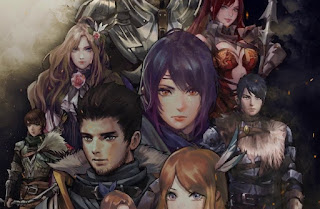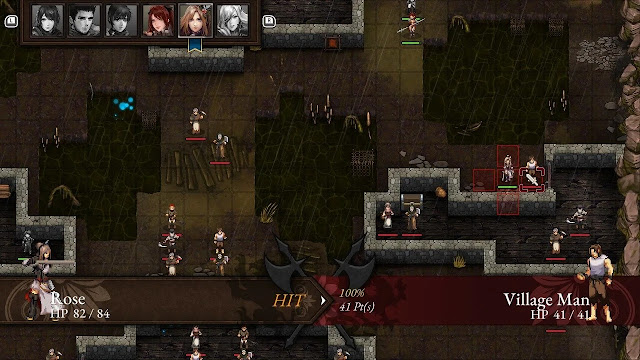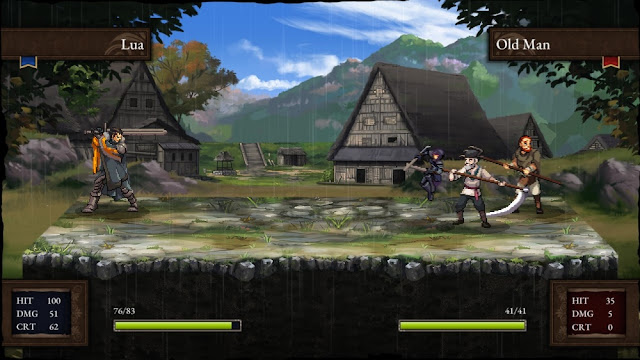I have a voracious appetite for tactics JRPGs. Especially if they look and feel like Fire Emblem. I’ve never forgotten just how much I fell in love with the first Fire Emblem to be released in English (the on the Game Boy Advance, and I swear it wasn’t just because, even as pixelated as it was back then, I had a real thing for leading lady Lyn and her legs). That game had such a powerful impact on me that I will immediately pick up anything that resembles that experience. Rise Eterna is clearly beholden to the classic Fire Emblem titles. The problem is that the developers didn’t quite have the capacity to deliver an equivalent experience.
The biggest problem is that the entire reason to play any Fire Emblem is the characters. It’s not just the explicit narrative, but because the character design is always so distinctive and beautiful, the animation always carries a fair bit of personality, and the characters all have charming little vignettes with one another that is unrelated to the main story. For these reasons and more, every single Fire Emblem title is largely driven by your desire to make the party of your favourite characters work. Rise Eterna has Lua, and while she’s the best of the bunch she’s simply not in the same league as characters like Lyn. That’s the most generous way I can put it. She’s a girl that’s gone through a tragedy, and yet it’s difficult to really care about her, because her character arc is stilted and she’s just not that charismatic.
The same goes for the rest of the cast. The developers have done almost everything right, in that they understand that each character needs to look and behave differently (as in Fire Emblem) and needs to get their own moment in the spotlight, but the value of a quality writer (and, potentially, translator) becomes clear when the banter between the characters in Rise Eterna tends to fall flat, the pacing is all over the place, motivations don’t always make sense, and the designs of both the heroes and the villains aren’t all that memorable.
There was a lot to be enthusiastic on the battlefield too… at first. Sadly, it doesn’t take long for the game’s weaknesses to become an issue. The big one is that characters don’t level up by experience. A big part of Fire Emblem’s strategy is in making sure that the right characters are the ones to defeat enemies, because the pool of available experience points is limited and you need to be careful to level your overall force up well. Focus too many experience points on one character and watch as later levels become impossible, and while that is certainly a potential strike against Fire Emblem, it’s also something that makes every single experience point (and therefore every battle) highly strategic.
In Rise Enterna, the alternative system is that every time a character survives a battle, they get a skill point, which can be used to boost stats or unlock the occasional special ability from a skill tree. At first, this system feels liberating. You don’t need to micro-manage individual characters through battles, and level-ups for all characters occur at a steady, predictable rate. The problem is that it makes the skirmishes themselves less intense and engaging. The skill trees are also far too shallow to be strategic in their own right, and Rise Eterna eventually starts to feel like it’s dragging its feet, particularly when difficulty spikes are thrown in and start mandating that levels be replayed for just one of these skill points each time.
Speaking of the levels, they are far, far too large in size. I’m guessing the developers were going for “epic” here, but the side of the battle maps have a couple of unfortunate side-effects which hamper the experience. Enemies are fought in groups, for a start, with each group being four or five large, while the other groups wait for your party to get close before they start their own attacks. The idea here being that you deal with groups systematically. I’ve seen some other reviews chalk that up as a negative point of difference in Rise Eterna, in that it’s hardly immersive when hordes of enemies just hang around while you beat up their buddies, but it’s actually a system common to the genre. If you play a Fire Emblem game carefully you’ll realise that, for the most part, you’re also tackling the enemies as distinct groups. Occasionally there will be mid-level triggers that would cause the next group to attack if you’re taking too long to progress (and Rise Eterna does indeed lack those, to its detriment), but it is fundamentally true that Fire Emblem’s enemies are split into manageable units, so I can’t fault Rise Eterna for doing the same.
The difference is that in Rise Eterna, the maps are huge and the groups are far apart. Fire Emblem is designed so that you’re only ever a space or two away from triggering the next wave of enemies just as you finish mopping up the last mob. Rise Eterna’s levels typically feature a few turns of overland wandering, and that adds a lot of downtime between groups. That downtime is a very dull experience indeed, filled with collecting resources for a rudimentary and unnecessary crafting system, and picking the lock of the occasional chest.
Another complaint that I’ve seen levelled at Rise Eterna is that characters can only equip one weapon, and this, too, is pretty similar to Fire Emblem, but again the devil’s in the details; in Rise Eterna there’s hardly any variation in classes. Outside of movement range and attack range, each unit behaves much more alike than, say, knights and swordsmen would in a Fire Emblem advenure. Instead of building the variation into the units themselves, the developers rely on a “gemstone” system to give you manual control to differentiate the characters from one another. One gem might boost attack while weakening defence, for example, and each character can equip a few of these. It’s a decent idea, but it’s too subtle to really enjoy in the context of the battlefield, with the end result being that all the characters still feel limited and samey in utility.
What Rise Eterna gets right is the aesthetics of the combat. The top-down tactical map is appealing, as is the little cut scenes of units fighting. The developer has gone with what seems like a high-density pixel art approach to character sprites, and it’s both appealing retro and fluid-like you’d expect from a modern game. I never grew tired of these little combat cut scenes, and those were the closest I got to enjoying particular characters, too. I found myself using characters that had the most appealing attack animations as much as possible, even if I didn’t overly care for the characters themselves… In fact, in drawing this review to a close perhaps the most telling comment I can make about Rise Eterna is that I play Fire Emblem explicitly for the characters, and while Rise Eterna tries to be a Fire Emblem in all but name, I can only remember the name of Lua.
Rise Eterna is not terrible by any means. It’s a perfectly playable effort to emulate Fire Emblem. But it’s also incredibly shallow, lacks character and meaningful narrative, and misfires in several critical areas with the gameplay. On the other hand, since Nintendo and Intelligent Systems are showing no haste in announcing a new Fire Emblem, I guess we’ve got to take what we can get.
– Matt S.










